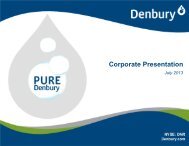Interactive 2009 Annual Report (PDF 7.56 MB) - Denbury Resources ...
Interactive 2009 Annual Report (PDF 7.56 MB) - Denbury Resources ...
Interactive 2009 Annual Report (PDF 7.56 MB) - Denbury Resources ...
- No tags were found...
Create successful ePaper yourself
Turn your PDF publications into a flip-book with our unique Google optimized e-Paper software.
<strong>Denbury</strong> <strong>Resources</strong> Inc. <strong>2009</strong> <strong>Annual</strong> <strong>Report</strong> 49In addition to our natural source of CO 2 and the proposed gasification plants discussed above (see “Off-BalanceSheet Arrangements – Commitments and Obligations”), we continue to have ongoing discussions with owners ofexisting plants of various types that emit CO 2 which we may be able to purchase. In order to capture such volumes,we (or the plant owner) would need to install additional equipment, which includes at a minimum, compression anddehydration facilities. Most of these existing plants emit relatively small volumes of CO 2 , generally less than theproposed gasification plants, but such volumes may still be attractive if the source is located near our Green Pipeline.The capture of CO 2 could also be influenced by potential federal legislation, which could impose economic penalties forthe emission of CO 2 . We believe that we are a likely purchaser of CO 2 produced in our area of operations becauseof the scale of our tertiary operations, our CO 2 pipeline infrastructure, and our large natural source of CO 2 (JacksonDome), which can act as a swing CO 2 source to balance CO 2 supply and demand.Overview of Tertiary Economics. When we began our tertiary operations several years ago, they were generallyeconomic at oil prices below $20 per Bbl, although the economics varied by field. Our costs have escalated during thelast few years due to general cost inflation in the industry and higher oil prices, and we estimate that our currentbreak-even, before corporate overhead and interest, is in the mid-thirties per barrel if oil prices remain at their currentlevel (approximately $70 per barrel). Our inception-to-date finding and development costs (including future developmentand abandonment costs but excluding expenditures on fields without proven reserves) for our tertiary oil fields throughDecember 31, <strong>2009</strong>, are approximately $12.68 per BOE. Currently, we forecast that most of these costs will averageless than $10 per BOE over the life of each field, depending on the state of a particular field at the time we beginoperations, the amount of potential oil, the proximity to a pipeline or other facilities, and other factors. The finding anddevelopment costs to date do not include additional probable reserves in fields with current proved reserves. Ouroperating costs for tertiary operations are highly dependent on commodity prices and could range from $15 per BOEto $25 per BOE over the life of each field, again depending on the field itself.While these economic factors have wide ranges, our rate of return from these operations has generally been betterthan our rate of return on traditional oil and gas operations, and thus our tertiary operations have become our singlemost important focus area. While it is extremely difficult to accurately forecast future production, we do believe that ourtertiary recovery operations provide significant long-term production growth potential at reasonable rates of return, withrelatively low risk, and thus will be the backbone of our Company’s growth for the foreseeable future. Although webelieve that our plans and projections are reasonable and achievable, there could be delays or unforeseen problems inthe future that could delay or affect the economics of our overall tertiary development program. We believe that suchdelays or price effects, if any, should only be temporary.Financial Statement Impact of CO 2 Operations. Our increasing emphasis on CO 2 tertiary recovery projects hassignificantly impacted, and will continue to impact, our financial results and certain operating statistics. First, there is asignificant delay between the initial capital expenditures on these fields and the resulting production increases, as wemust build facilities, and often a CO 2 pipeline to the field before CO 2 flooding can commence, and it usually takes six to12 months before the field responds to the injection of CO 2 (i.e., oil production commences). Further, we may spendsignificant amounts of capital before we can recognize any proven reserves from fields we flood (see “Analysis of CO 2Tertiary Recovery Operating Activities” below). Even after a field has proven reserves, there will usually be significantamounts of additional capital required to fully develop the field.Second, tertiary projects may be more expensive to operate than other oil fields because of the cost of injecting andrecycling the CO 2 (primarily due to the significant energy requirements to re-compress the CO 2 back into a near-liquidstate for re-injection purposes). Since a significant portion of our operating costs vary along with commodity and electricalprices, these costs are highly variable and will increase in a high commodity price environment and decrease in a lowprice environment. As an example (as discussed above), during <strong>2009</strong> the cost of our CO 2 varied from $0.13 per Mcf to$0.21 per Mcf. Most of our CO 2 operating costs are allocated to our tertiary oil fields and recorded as lease operatingexpenses (following the commencement of tertiary oil production) at the time the CO 2 is injected, and these costs havehistorically represented over 25% of the total operating costs for a tertiary operation. Since we expense all of the operatingcosts to produce and inject our CO 2 (following the commencement of tertiary oil production), the operating costsper barrel will be higher at the inception of CO 2 injection projects because of minimal related oil production at that time.Management’s Discussion and Analysis of Financial Condition and Results of OperationsForm 10-K Part II




